
young caterpillar, magnified
(Photo: Don Herbison-Evans, Bundaberg, Queensland)
The Caterpillars of this moth feed on the pads
(cladodes) of
the several pest species of Opuntia that were unfortunately
introduced into Australia, especially including:
Prickly Pear ( Opuntia stricta
CACTACEAE ).
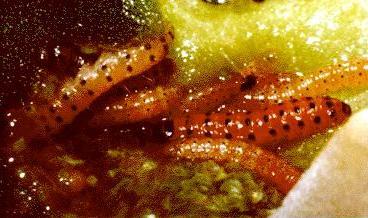
older caterpillars
(Photo: Don Herbison-Evans, Bundaberg, Queensland)
The caterpillars live and feed communally inside the tough leathery
(and prickly) skin of the host plant, reducing the plant material
inside to a gooey green mess. The caterpillars are initially
pinkish-cream coloured, with dark red dots on the back of each segment.
Later instars
become orange, and the dots expand and then fuse to become a dark band
across each segment. The caterpillars grow to length of about 1.5 cms.
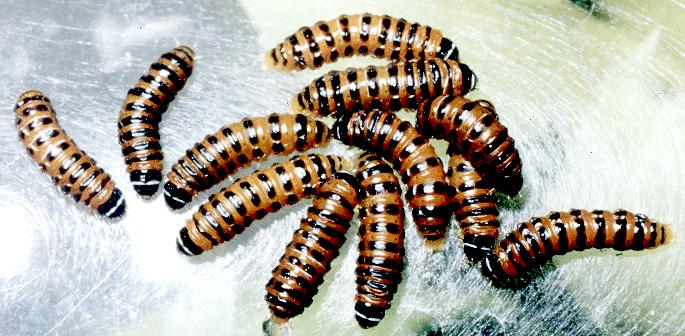
(Photo: Don Herbison-Evans, Bundaberg, Queensland)
They normally pupate in white cocoons amongst the ground debris.
In captivity, some pupated at the top of their jar, and some at the bottom.

(Photo: Don Herbison-Evans, Bundaberg, Queensland)
The adult is fawn with faint dark dots and lines on the wings.
The moth normally rests with its wings wrapped
around its body. The moth has a wingspan of about 2 cms.
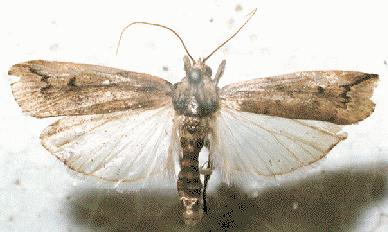
(Specimen: courtesy of the
Macleay Museum, University of Sydney)
The species was originally found in Argentina, but was
introduced to Australia in 1926 by the
release of 2,000,000 eggs near the
town of Chinchilla,
in order to control the
Prickly Pear
which was overtaking much of Queenland.
For the same reason, the species has been introduced into other
countries, including:
Caribbean Islands,
Hawaii, and
South Africa.
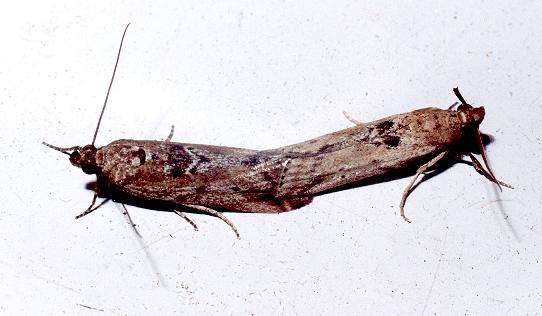
mating pair of adult moths
(Photo: Don Herbison-Evans, Bundaberg, Queensland)
The species is now common over
Queensland,
New South Wales, and
South Australia,
and the Prickly Pear has been reduced to isolated plants of little
economic significance.
Unfortunately, the moth has also spread to
the mainland of north America, and has
become a pest there on the local cacti.
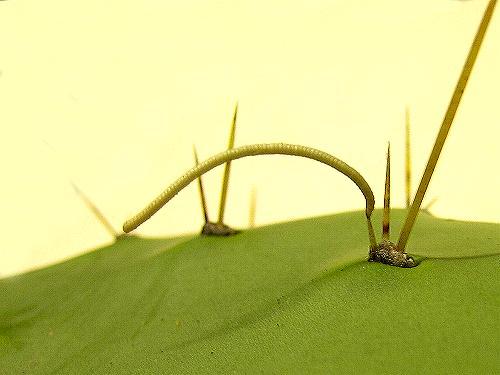
egg pile on a cactus spine
(Photo: Don Herbison-Evans, Bundaberg, Queensland)
The eggs are laid on top of each other. like a stack of coins,
the first one being anchored to a cactus spine.
The stack can contain over 100 eggs, and curves over to make a kind of
bent stick with a length of up to 2 cms. When they hatch, the young
caterpillars walk down the stick and start burrowing into the cactus.
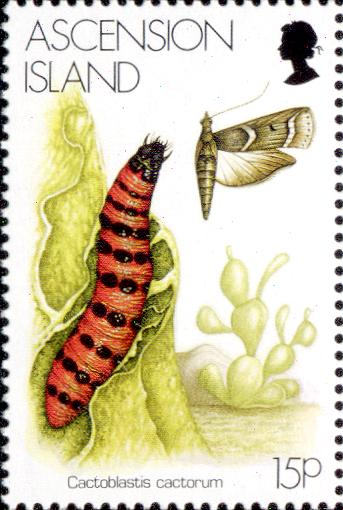
Ascension Island, 1998
Further reading :
Cárlos Berg,
Quindecim Lepidoptera nova faunae Reipublicae Argentinae et Uruguayensis,
Annales Societe Ciencias Argentina,
Volume 6, Part 19 (1885), p. 276.
Ian F.B. Common,
Moths of Australia,
Melbourne University Press, 1990, fig. 32.3, pl. 25.14, pp. 58, 72, 349.
Paul Zborowski and Ted Edwards,
A Guide to Australian Moths,
CSIRO Publishing, 2007, pp. 28, 128.
(updated 19 October 2010, 27 March 2019, 17 July 2020)













